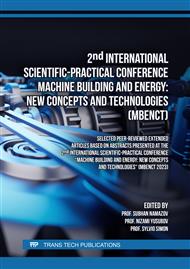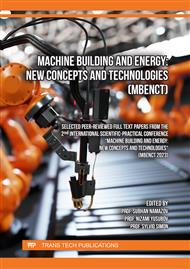[1]
B.A. Avdeev Elements and functional devices of ship automation. textbook. St. Petersburg: High Technology, 2018.
Google Scholar
[2]
A.S. Shaginyan, V.V. Bolotsky Electro-hydraulic amplifiers: Monograph. Gomel: Educational Institution Sukhoi State Technical University of Gomel. 105 p.
Google Scholar
[3]
P.M. Kuznetsov, V.K. Moskvin A review of electro-hydraulic drives used in industrial robots and robotic technological complexes. Innovative Science International Scientific Journal, 5, (2016), 144–150.
Google Scholar
[4]
V.F. Bolyukh, S.V. Oleksenko, I.S. Shchukin A comparative analysis of induction-dynamic, electrodynamic and electromagnetic shock electromechanical converters. Bulletin of NTU Kharkiv Polytechnic Institute. 38(1081), (2014). 30-44
DOI: 10.15407/techned2016.05.046
Google Scholar
[5]
V. I. Razintsev, S. N. Kulikov, S.V. Volkov, L.A. Razintseva Microprocessor-controlled electro-hydraulic power amplifiers. Russian Engineering Research, 33, (2013), 385–388.
DOI: 10.3103/s1068798x13070149
Google Scholar
[6]
V.F. Bolyukh, Yu.V. Kashansky, I.S. Shchukin The influence of the geometric parameters of the inductor and armature on the performance of a linear electrodynamic pulse electromechanical converter. Electrical Engineering and Electromechanics. 3 (2019), 11-17.
DOI: 10.20998/2074-272x.2019.3.02
Google Scholar
[7]
M.Ya. Khiterer, I.E. Ovchinnikov Synchronous electric machines of reciprocating motion: manual for "Electromechanics" and "Electric Drive and Automation" specialties. St. Petersburg, CORONA Print, 2013. 368 p.
Google Scholar
[8]
A.B. Menzhinsky, A.N. Malashin, Yu.V. Sukhodolov The development and analysis of mathematical models of linear and reciprocating generators with electromagnetic excitation. Power Engineering. News of CIS Universities and Energy Associations61, 2. (2018) 118–128. https://doi.org/10.21122/1029- 7448- 2018-61-2-118-128.
DOI: 10.21122/1029-7448-2018-61-2-118-128
Google Scholar
[9]
Z. Zhang, M. Luo, J. Duan, B. Kou Performance Analysis of Double-Sided Permanent Magnet Linear Synchronous Motor with Quasi-Sinusoidal Ring Windings. IEEE Trans. Energy Convers. 35 (2020), 1465–1474.
DOI: 10.1109/tec.2020.2981634
Google Scholar
[10]
V.G. Gerasimov Electrotechnical Handbook: In 4 volumes. Vol. 1. General issues. Electrical materials. Moscow: Publishing House of Moscow Power Engineering Institute, 2007. 440 p. URL: https://www.studentlibrary.ru/book/ISBN9785383000823.html (access date: 21.09.2023). – Access mode: subscription.
Google Scholar
[11]
D.F. Khabarova, S.Yu. Bityutskikh, A.R. Ismagilov, D.V. Ardashev Determining the hydrodynamic force acting on the spool of an electro-hydraulic power amplifier using computational hydrodynamical means. Bulletin of the SUSU. Ser. Mechanical Engineering Industry, 23, 2 (2023), 5–16.
DOI: 10.14529/engin230201
Google Scholar
[12]
K. Atallah, D. Howe, P. H. Mellor, D. A. Stone, Rotor loss in permanent-magnet brushless AC machines, IEEE Transactions on Industry Applications, 36, 6 (2000), 1612-1618.
DOI: 10.1109/28.887213
Google Scholar
[13]
S.A. Gandzha, A.I. Sogrin, I.E. Kiessh The Comparative Analysis of Permanent Magnet Electric Machines with Integer and Fractional Number of Slots per Pole and Phase. International Conference on Industrial Engineering, Procedia Engineering 129 (2015) 408–414.
DOI: 10.1016/j.proeng.2015.12.137
Google Scholar
[14]
N. Schofield, K. Ng, Z.Q. Zhu, D. Howe Parasitic Rotor Losses in a Brushless Permanent Magnet Traction Machine. Eighth International Conference on Electrical Machines and Drives 444 (1997) 200-204.
DOI: 10.1049/cp:19971067
Google Scholar
[15]
G.L. Sipailov et al. Thermal, hydraulic and aerodynamic calculations in electric machines. Moscow: Vyschaya Shkola, 1989, 239 p.
Google Scholar



